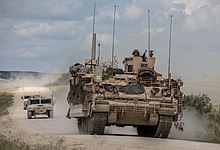|
Next Generation Combat VehicleThe Next Generation Combat Vehicle (NGCV) is a United States Army program intended to procure a variety of armored vehicles to add new capabilities to Army units and replace existing platforms that are nearing the end of their service life. The program covers the following systems:[1]
DevelopmentThe project began in 2017 after the previous Ground Combat Vehicle program was canceled. The deadline of the projects is expected to be 2035. Multiple groups competed for the bid. The Army gave the contract to a six member consortium - Lockheed Martin, SAIC, GS Engineering, Inc., Moog Inc., Hodges Transportation Inc. and Roush Industries.[5][6] Armored Multi-Purpose Vehicle The Armored Multi-Purpose Vehicle (AMPV) is the replacement for the M113. In 2014, the Army selected BAE Systems' proposal of a turretless variant of the Bradley Fighting Vehicle. As of 2015[update] the program was scheduled to deliver 2,897 AMPVs in five variants. Mobile Protected Firepower Mobile Protected Firepower is a fire support vehicle.[7] It is similar to the M8 Armored Gun System program canceled in 1996, or the M1128 mobile gun system being retired in 2022. In November 2019, the Army released a request for proposals for the Mobile Protected Firepower.[8] In December 2018, the Army downselected BAE Systems' and General Dynamics Land Systems' proposals to move forward.[9] BAE offered a vehicle based on the M8 Armored Gun System. GDLS offered a variant of the Griffin II.[9] On June 28, 2022, the Army selected the GDLS Griffin II light tank as the winner of the MPF program, with an initial contract for 96 vehicles. In June 2023, the Army designated the Mobile Protected Firepower combat vehicle as the M10 Booker after Private Robert D. Booker, who was killed in the North African campaign during World War II, and Staff Sergeant Stevon Booker, who was a tank commander during the Battle of Baghdad.[10] XM30 Mechanized Infantry Combat VehicleThe XM30 Mechanized Infantry Combat Vehicle (MICV), formerly known as the Optionally Manned Fighting Vehicle (OMFV) is the Army's replacement for the M2 Bradley. In June 2018, the Army established the Next Generation Combat Vehicle (NGCV) program to replace the M2 Bradley. In October 2018, the program was re-designated as the Optionally Manned Fighting Vehicle (OMFV). The NGCV program was expanded as a portfolio of next-generation vehicles including tanks and the Bradley-based Armored Multi-Purpose Vehicle.[11] In March 2019, the Army released a request for proposals for the OMFV.[12] The Army said the OMFV will be designed "to engage in close combat and deliver decisive lethality during the execution of combined arms maneuver," and will have a 30mm cannon and a second-generation forward looking infrared system, or FLIR. Testing of the vehicle is expected to begin in 2020.[12] A joint venture between Raytheon and Rheinmetall offered a variant of the Lynx KF41. General Dynamics Land Systems offered a variant of the Griffin III. Both Raytheon-Rheinmetall and GDLS were disqualified, leaving no other competitors.[13] The Army decided to restart the program with less-stringent guidelines.[14] In July 2021, the Army awarded contracts to five teams: Point Blank Enterprises, Oshkosh Defense, BAE Systems, General Dynamics Land Systems and American Rheinmetall Vehicles. The total value of the contract was $299.4 million. Teams will develop concept designs during the 15-month long phase.[15] In June 2023, the Army downselected American Rheinmetall and GDLS to go forward in the competition. These two teams will now move on to the next phase of the programme and split a $1.6 billion development fund to develop a total of eleven prototypes each, seven being for a contract award, with an option for four more. They will also develop two ballistic hulls, turrets, armor coupons, and digital model twins during this phase of the programme. The Army announced that due to the initial design stage of the OMFV being complete, that they would be redesignating the programme as the XM30 Mechanized Infantry Combat Vehicle.[16] Robotic Combat VehicleAs of December 2021[update], Robotic Combat Vehicle (RCV) is not a Program of Record, meaning the Army has not committed to an acquisition plan.[17] The RCV is being developed in light, medium and heavy variants. The RCV-Light weighs no more than 10 tons, the RCV-Medium weighs between 10 and 20 tons, and the RCV-H weighs more than 20 and less than 30 tons.[17] In January 2020, the Army awarded contracts to Qinetiq and Textron. Qinetiq will build four RCV-Ls, and Textron will build four RCV-Ms.[17] Decisive Lethality Platform
See also
References
|
Portal di Ensiklopedia Dunia